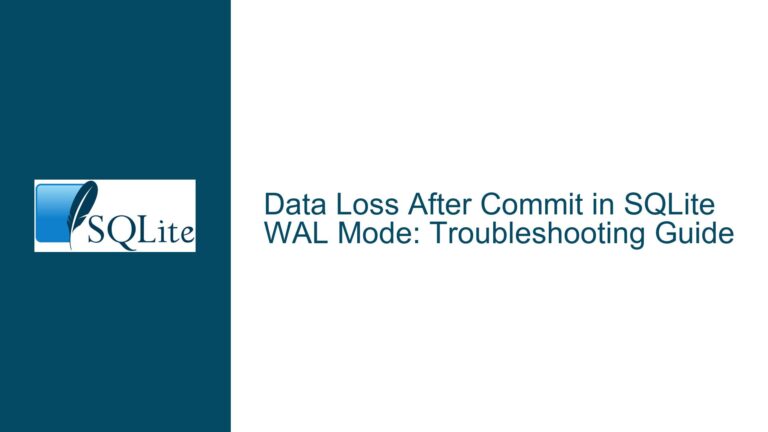Resolving Database Locked Exceptions in Multithreaded SQLite Applications
Understanding the Database Locked Exception in Multithreaded Environments
The database locked exception in SQLite is a common issue that arises in multithreaded applications where multiple threads attempt to access the database concurrently. This exception occurs because SQLite employs a file-based locking mechanism to ensure data integrity. When one thread is writing to the database, it locks the database file, preventing other threads from performing write operations until the lock is released. This locking mechanism is essential for maintaining consistency but can lead to bottlenecks in high-concurrency scenarios.
In the provided scenario, the application is experiencing database locked exceptions despite setting a busy timeout in the connection string. The busy timeout parameter instructs SQLite to wait for a specified amount of time (in milliseconds) for the lock to be released before throwing an exception. However, this approach alone may not suffice if the transactions are long-running or if the application design does not account for SQLite’s concurrency limitations.
Identifying the Root Causes of Database Locked Exceptions
The database locked exception can stem from several underlying causes, each requiring a different approach to resolve. One primary cause is the presence of long-running write transactions. SQLite does not support concurrent write transactions, meaning that if one thread is performing a write operation, other threads attempting to write will be blocked until the first transaction completes. If the transaction takes longer than the busy timeout, the waiting threads will throw a database locked exception.
Another potential cause is the use of the default journaling mode (DELETE or TRUNCATE) instead of Write-Ahead Logging (WAL). The default journaling modes require exclusive locks during write operations, which can exacerbate locking issues in multithreaded environments. WAL mode, on the other hand, allows one writer and multiple readers to operate concurrently, significantly improving concurrency.
Additionally, the application’s connection management strategy can contribute to locking issues. If the application uses a single shared connection across multiple threads, it can lead to contention and locking problems. Each thread should ideally have its own connection to the database, with proper connection pooling to manage resources efficiently.
Implementing Solutions to Prevent Database Locked Exceptions
To address the database locked exception, several strategies can be employed, each targeting a specific aspect of the problem. First, optimizing transaction duration is crucial. Long-running transactions should be broken down into smaller, more manageable units of work. This reduces the time the database is locked, allowing other threads to perform their operations more quickly. For example, if a transaction involves multiple steps, consider committing the transaction after each step rather than waiting until the end.
Switching to WAL journaling mode is another effective solution. WAL mode allows one writer and multiple readers to operate concurrently, reducing the likelihood of locking issues. To enable WAL mode, execute the following command using the SQLite command-line tool:
PRAGMA journal_mode=WAL;
This command needs to be executed only once, as the journaling mode is stored in the database file. After enabling WAL mode, the application should experience improved concurrency and fewer locking issues.
Proper connection management is also essential. Ensure that each thread has its own connection to the database, and use connection pooling to manage these connections efficiently. Connection pooling helps reduce the overhead of establishing and closing connections, improving performance and reducing contention.
In some cases, the application’s design may need to be revisited to minimize the need for concurrent write operations. For example, if multiple threads frequently update the same table, consider batching these updates or using a queue to serialize write operations. This approach can help reduce contention and prevent locking issues.
Finally, monitoring and profiling the application can provide valuable insights into the root causes of locking issues. Use SQLite’s built-in profiling tools or third-party monitoring solutions to identify long-running transactions, frequently locked tables, and other potential bottlenecks. Armed with this information, you can make targeted optimizations to improve performance and reduce locking issues.
In conclusion, resolving database locked exceptions in multithreaded SQLite applications requires a multifaceted approach. By optimizing transaction duration, enabling WAL journaling mode, managing connections effectively, and revisiting the application’s design, you can significantly reduce the occurrence of locking issues and improve overall performance.






